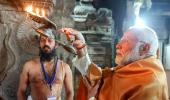Saisuresh Sivaswamy/Rediff.com decodes Prime Minister Modi's speech after the pran prathistha ceremony in Ayodhya.

There are two lingering images from Monday's pran pratishtha ceremony.
One is of Prime Minister Narendra Modi prostrating himself before Ram Lalla, bringing to mind another instance, in 2014, when he had bowed down when he entered Parliament for the first time on being elected as the prime minister. In 2019, too, on being elected as the leader of the newly-elected MP of the NDA, he touched a copy of the Constitution of India with his forehead.
If there was any misgiving in anyone's mind about the Constitutional niceties of an elected prime minister conducting a religious ceremony, in his speech at the Ram temple soon after the consecration Modi sought to draw a link between the two stating that the original copy of the Constitution of India has images of Lord Ram, Sita and Lakshman on the page on Fundamental Rights of citizens.
The other image was of Modi striding down the temple after the ceremony and speech, unaccompanied by the others from the consecration like Chief Minister Yogi Adityanath or RSS Sarsanghchalak Mohan Bhagwat, and walking down to the VIP enclosure and greeting the attendees from his side of the barricade.

The message was very clear: Others may have participated in the consecration ceremony, but let it be known it really was him and him alone who is the public face of the Ram mandir inauguration.
One of the scribes watching the event on giant screens in the media room remarked, "That is what a victory march looks like."
And victory mark indeed it was.
He also made it a point to emphasise on two other points.
Referring to the long-drawn-out dispute over the Ram mandir and the dire predictions that construction of a temple will lead to "fire", Modi indirectly addressed the critics of the Ram mandir ceremony saying that Ram can never be a destructive force as fire, but he was urja, or "energy".
"Such people could not understand the purity of India's social spirit. The construction of this temple of Ram Lalla is also a symbol of peace, patience, mutual harmony and amity in the Indian society. We are witnessing that this construction is not giving birth to any fire, but to energy."
And he also touched upon the dispute's resolution in his own manner when he thanked the Indian judiciary for "preserving the dignity of justice". "The temple to Ram, a model of justice himself, was built in a just manner."

This was the closest the prime minister came to mentioning the long and divisive background to the Ram temple. To the critics, his rebuttal was clear: It was done in a just manner.
For this, he has the seal of approval of the myriad VIPs who were present on the occasion cheering him and the ceremony as well as the thousands of devotees lined up outside the temple.
Modi also remarked that the Kaal Chakra was changing, as it had changed during Ram's time. "January 22, 2024 is the beginning of the a new era," he said.
Making it clear that the task was not over with the construction of the temple, Modi said that the foundation of a new India has been laid for the next 1,000 years, as India moved from "Dev to Desh, Ram to Rashtra."
Modi's speech also echoed the sentiment on the street when he said, "A nation rising up after breaking the mentality of slavery, a nation taking courage from every bite of the past, creates a new history in this way."

At the same he was also clear that this was not a moment of victory alone. "For us, this is not a time of victory but also of humility."
"The history of the world is witness to the fact that many nations get entangled in their own history. Whenever such countries tried to untie the tangled knots of their history, they faced great difficulty in achieving success. In fact, many times situations became more difficult than before. But the seriousness and emotion with which our country has opened this knot of history, shows that our future is going to be much more beautiful than our past."
The prime minister in his speech also made a mention about what next after the Ram temple -= at a time when two other ancient sites sacred to Hindus are caught in a legal tussle.
"Today the land of Ayodhya is asking some questions to all of us, to every Ram devotee, to every Indian. The grand temple of Shri Ram has been built...now what next? The wait of centuries is over...what next?" and even remarked, "This is the time, this is the right time."
But for those who expected the prime minister to make a statement of intent about Kashi and Mathura, he remained silent on them, choosing to say instead, "From today, from this sacred time, we have to lay the foundation of the India of the next thousand years. Moving ahead with the construction of the temple, now all of us countrymen take an oath to build a strong, capable, grand and divine India from this very moment."
Feature Presentation: Aslam Hunani/Rediff.com










